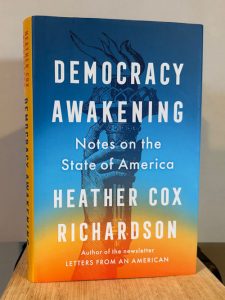Subtitled “Notes on the State of America”
(Viking, Sep 2023, xvii + 286pp, including 30p of notes and index)
Heather Cox Richardson is a historian who has become well-known, in addition to several earlier books, for her newsletter called Letters from an American, now on Substack. I don’t recall how I first heard of her, probably on Facebook, her Wikipedia entry suggests. (That entry notes that her newsletter is the most successful on Substack, bringing in $1 million/year. She’s the most prominent in a trend of influential thinkers to abandoned traditional media for independent subscription-based platforms, even though most of their content is free. Paul Krugman being the latest.)
This book takes a century-long view of America, explaining how we got to the point where someone like Trump could be elected president. It was published in 2023, and of course she continues to narrate history as it unfolds in her daily posts. Her style is straightforward and equanimous, matter-of-fact in describing the situation without seeming overly partisan. I started this book when it came out in late 2023, put it aside for some reason, and finished reading it last August. And now am finally writing it up here.
As I review the fairly extensive notes I took for the book, I think I’ll polish a bit and post them in their entirety, if perhaps over a couple three days. (Rather than boil my comments down to a few bullet points or paragraphs.) And I’ll bold highlights for ease of skimming. The first section is a history of the US from FDR to Trump, and covers the first 79 pages of the book.
Two main ideas run through the book, and are among passages highlighted below. First, her definition of fascism. Second, her description of what she calls the “liberal consensus” that ran from FDR at least until Reagan (meaning liberal in the broadest sense, and not as a synonym for Democrat). I’ll have more comments after the summary is complete in the next post or two.
\
Foreword
America is at a crossroads, teetering on the brink of authoritarianism. How did it happen? Is the fall of America inevitable? Democracies more often die at the ballot box than at gunpoint. Why would voters do this? We can look back at Germany in the 1930s.
Authoritarians rise through use of language and false history. They rise when a formerly powerful group feels left behind. A strongman promises to make them dominant again. They’ve been cheated, and those who’ve cheated them are evil.
Somehow the US avoided this in the 1930s. It came close, in 1939. The US has an actual history of struggles, leading to the idea that all people are equal. Fascism, in contrast, was based on the idea that some people are better than others, and deserved to rule. Even in the US, when marginalized people might get an equal voice, certain political leaders told white men they were under attack. Defenders of slavery; resistors of civil rights in the 1950s; then again with a political minority in the years after 1980. Then Trump followed the fascist playbook apparent from the 1930s, eventually trying to overturn the 2020 election. Now they argue that democracy is obsolete.
Critics of democracy say its focus on individual rights undermines the traditional (religious) values that Founders intended to be imposed on citizens. Richardson doesn’t buy it. She believes the founders meant that humans have the right to determine their own fate.
This book is about a small group of people who’ve tried to make you believe that our fundamental principles aren’t true. “…promising to re-create an imagined past where those people could feel important again.” (pxvii.7)
It’s also a book about how democracy has persisted, despite past attempts to undermine it.
Part 1, Undermining Democracy
Ch1, American Conservatism, p3
Author summarizes history since the 1920s. Republicans controlled congress; FDR’s New Deal; ‘conservative’ opposition to it. Racists in the south, then Democrats, hated FDR’s new system. They and northern Republicans produced a Conservative Manifesto, rejecting the idea of public spending and prioritizing private investment. Tax cuts, and cuts to social welfare spending. States’ rights. Whites-only organizations endorsed it. But there’s was not the historical meaning of conservatism in America.
That came from Edmund Burke during the French Revolution: his idea was the government should promote stability, supporting social hierarchies, the church, property, and family. Conserve what was already there. Yet in America there wasn’t much long-standing to preserve. The word took on new meaning in debates about slavery — as an American tradition worth preserving. White dominance over subject races. That take was challenged—it wasn’t in the Declaration. A Republican Party, including Lincoln, formed to oppose slavery. Republicans then created public universities, invented income tax, and ended Black enslavement. That is, promoting the principles of the Declaration.
Ch2, The Liberal Consensus, p11
The New Deal had its problems. Then Japan bombed Pearl Harbor on Dec 7, 1941, and other countries also declared war on the US. The pact of Japan, Italy, and Germany represented a new political ideology. Mussolini gave up on socialism, and rejected the equality inherent in democracy, believing that those who were better should lead the others, themselves led by a dictator. This was “fascism.” Hitler adopted the idea, and claimed Germany was the successor to the Holy Roman Empire—an appeal to traditional ideology. Meanwhile America highlighted stories of individual heroes. American’s mixed armed forces won the war. By the end the victory seemed to confirm FDR’s approach: business regulations, a basic social safety net, investment in infrastructure. Meanwhile it was obvious that all Americans were not treated equally, e.g. sexual assaults by whites in the South. The NAACP took up their cause. FDR and Truman failed to move civil rights legislation, but Eisenhower and Earl Warren began, with Brown v. Board of Education.
Ch3, Bringing the Declaration of Independence to Life, p17
Recalls 1946 incident in which a black soldier was beaten by a policeman and was left blind. The case rose to the attention of Truman; the policeman was charged but acquitted in self-defense. Truman formed a committee on civil rights, and moved toward anti-discrimination rules. Another incident in 1949 led to a black soldier killed in the Philippines to be buried in Arlington National Cemetery, arranged by senator Lyndon Johnson. Racist southern Democrats blocked the movement, until Eisenhower appointed Earl Warren chief justice, who in turn led the argument about ‘separate but equal’ and the 14th amendment. The Supreme Court declared racial discrimination unconstitutional. White southerners, ignoring this, set up all-white schools. Emmett Till was murdered. His killers were acquitted. Then admitted their guilt. Later in 1955 came Rosa Parks on the bus. In 1957, black students tried to enroll at a school in Little Rock. Johnson signed on to a Civil Rights Act, despite a filibuster by Strom Thurmond. The act passed with majorities of both parties.
Ch4, Races and Taxes, p25
The ‘liberal consensus’ became popular, and included the notion that the government should promote civil rights. Opponents of this rolled out an alternative history based on racial hierarchy, claiming that defending civil rights redistributed wealth, and so was a kind of socialism. They were using it in a different sense than Marx did, of course.
Meanwhile, white southerners terrified of the idea of blacks voting against them began dressing up as the ghosts of dead confederate soldiers, in white robes, warning former slaves not to show up at the polls. They became the Ku Klux Klan. Whites argued that blacks, being poor, would vote for leaders who would build things, at the expense of whites, and this was socialism. They also objected to immigrants from southern and eastern Europe voting.
Meanwhile they glorified the American cowboy, who wanted nothing from the government but to be left alone. The antithesis to the government-backed socialism in the East. Buffalo Bill, et al., remained effective propaganda through the 1950s and 60s.
In 1951 William. F. Buckley Jr, frustrated by the government’s priorities, argued against Enlightenment principles that rejected leadership based on religion or birth. His book argued that universities must stop using the fact-based arguments that led to “secularism and collectivism” and instead teach values of Christianity and individualism. 29b. In his mind the world was Christians vs. communists and Jews for control of the world. They defended Joseph McCarthy. They divided America into two groups: “Liberals” (who among other things believed in fact-based argument, p30.3) and “conservatives” who prioritized businessmen who in turn gained the support of religious traditionalists, who also believed the liberal consensus served evil.
Most Americans didn’t buy it. Yet ‘Movement Conservatism’ (the opposite of Burke’s true conservatism) promoted the idea of the cowboy on TV in the 50s, with 26 different shows on the air in 1959. Bonanza ran 14 seasons. Cowboy mythology permeated politics on the right. E.g. Goldwater, who promoted the idea of a west free of government interference, with opposition to civil rights. His book The Conscience of a Conservative was a manifesto against the liberal consensus. And appealed to racism.
Ch5, Nixon and the Southern Strategy, p33
JFK won in 1960 but carefully didn’t mention racial justice in his inaugural address. But when a black veteran was refused enrollment at the University of Mississippi, attorney general RFK ordered it to. Whites rallied for the cause of their “freedom”; riots killed two men. The vet was enrolled. Conservatives called the Kennedy brothers communists. JFK visited Dallas to mend fences – “heading into nut country” – and was assassinated. In 1964 three voting rights workers disappeared in Mississippi. In response Johnson got congress to pass the Civil Rights Act of 1964, to make it easier to register to vote.
Goldwater ran for president in 1964 opposed to such government protections. Strom Thurmond backed him. Johnson spoke to Americans as one people. He won in a landslide, while Goldwater won in the deep south. After the election blacks stepped up efforts to register voters. A march in Selma, Alabama in 1965, was stopped by police with Billy clubs and tear gas. Johnson promised to overcome such bigotry and injustice. Then came the Voting Rights Act of 1965.
In response George Wallace formed his own party. Others in the south switched parties, from Democratic to Republican. Nixon personally asked Thurmond to, in return for relaxing enforcement of desegregation laws. This “southern strategy” marked the switch of the parties’ positions on race. Famous quote by Johnson about picking pockets 39.4:
If you can convince the lowest white man he’s better than the best colored man, he won’t notice you’re picking his pocket. Hell, give him somebody to look down on, and he’ll empty his pockets for you.
Thus the stage was set for the rise of authoritarianism.
Ch6, Positive Polarization, p41
The strategy was to appeal to emotion, divide the world into good Americans and those allegedly seeking to destroy it. Thinking is hard work, noted Nixon’s handlers. So they aimed at Black activism and the rise of the New Left on college campuses in the 1960s. In 1964 UC Berkeley students protested for racial equality and against the Vietnam War. Edwin Meese III, then D.A. for Alameda County, had hundreds of them arrested. Ronald Reagan was elected governor in 1966 by promising to “clean up the mess” at Berkeley. In 1968 Nixon played off riots in Chicago, pulling together a coalition of pro-business Republican, southern racists, traditionalists, and “law and order” voters to win the White House. But to win elections sometimes met cheating. So they worked against peace talks in Vietnam to hurt Democrats, who were identified as the dangerous “others.” Despite which, the war escalated. Patrick Buchanan and Lee Atwater stoked division and anger among voters. Nixon accused black and brown Americans of wanting government handouts. Old-fashioned bigots were on his side. The country polarized and the liberal consensus was shattered. The right was worried that corporate America was under attack by those advocating safety standards. The ACLU was bad for business. Right wing organizations pushed back—the Heritage Foundation, Hoover Institution, et al.
Nixon turned abortion into a wedge issue. Abortion practices were relatively liberal, but Pat Buchanan saw a way to attract antiabortion Catholic Democrats, so Nixon reversed course. Phyllis Schlafly spoke out against women’s lib. This made the liberal consensus anti-family agitators.
By 1972 Nixon felt he had to win to save America. So his reelection committee planted fake letters in papers, planted spies, tapped phones. Eventually this led to the exposure of the burglary at the Watergate office complex. But not until after the election, which he won handily. Once the story came out… he resigned. Yet his division of the world into good and evil took hold. Under Nixon, the US manipulated into Chile’s election to get dictator Augusto Pinochet installed in 1973.
Ch7, The Reagan Revolution, p49
Reagan came along six years after Nixon resigned and used some of his tactics, e.g. sabotaging the effort to get hostages released by Iran. He told stories pitting white men against “special interests” of black men. Conservatives worried about an economy that was actually booming since the 1950s. M/w Democrats were trying to be more inclusive. Conservatives made this a problem for white workers.
Reagan played up the story of the (black) “welfare queen” who lived off government benefits. M/w Little House on the Prairie portrayed an anti-New Deal vision, independent of the government. Reagan attracted right-wing religious groups. And supported Jerry Falwell and his Moral Majority. He used the slogan “make America great again” to refer to a time before blacks, browns, and women began to claim equal rights. Conservatives complained about the “liberal media” for challenging facts. When Reagan won, his inaugural speech claimed that “government *is* the problem.”
So he set out to undo the liberal consensus that followed World War II. He believed in “supply-side economics” and cut taxes for the wealthy. When the numbers didn’t play out, they reprogrammed the computers. They never did work out. Inequality grew. Taxes were cut, spending on public welfare was cut, and defense spending was increased. The national debt tripled. Jobs in defense, at least, were created.
Reagan was reelected, but Democrats won in congress. Conservatives ended the fairness doctrine. Radio hosts like Rush Limbaugh ranted on AM about “feminazis” etc. To bolster Bush against Dukakis, Atwater and Ailes produced the Willie Horton ad, propaganda filmed as if it were a news story. (Atwater apologized at the end of his life.) They attacked Dukakis for following the law. Newt Gingrich distributed a list of invectives to use when discussed Democrats, 56.4 (“refer to Democrats with words like corrupt, cheat, disgrace, endanger” and on and on).
Pat Buchanan gave a barn-burning speech that in effect kicked off the culture war [[ Prothero covers that ]] , establishing Democrats as the enemy, and emphasizing freedom over democracy. Republicans thus gave the underclass of Americans falling behind economically someone to hate.
Ch8, Skewing the System, p59
So Democrats were on the defensive. Republicans worked on their evangelical support, but in terms of family values. They began attacking ease of voting initiatives, and accused Democrats of “voter fraud.” (Nothing was found.) In 2000 Gore won the popular vote but lost the electoral college, and Republicans got the Supreme Court to stop the recount and declare Bush winner. M/w Sam Alito in 1986 had put forth the idea of presidential ‘signing statements,’ and in 87 Reagan approved it. This gave the president more power over American democracy. M/w they overturned the idea that the first ten amendments to the Constitution applied to states, promoting the idea of ‘originalism.’ Bork was so extreme even some Republicans voted against him. But the push to stack the courts was underway. Also the Reagan administration advanced “freedom” overseas by funding intervention in other country’s political systems. They funded the Contras in Nicaragua even after Congress forbade them to, by illegally selling arms to Iran. When discovered, Republicans were defiant. Eleven officials were convicted over it, but Bush pardoned them.
Ch9, A New Global Project, p67
The Soviet Union fell in 1991. Americans looked for socialist ideology at home. Authoritarian governments could get US aid by claiming they were fighting communists. Oligarchs took over the former Soviet republics, and aligned with Republicans who shared their hierarchical view of the world. Traditional Republicans, including George HW Bush, fell to Movement Conservatives who called them RINOs. Clinton won in 1992 and was demonized; Fox News debuted in 1996, feeding the idea that the left were socialists trying to destroy the country. Cheney, Rumsfeld, and others, promoted increased defense spending around the world. They concocted reasons to topple Saddam Hussein, but were stymied, until the 9/11 attacks gave them an excuse. The war was not popular at home, nor were ‘enhanced interrogation techniques.’
M/w money-laundering and other plots began… Republicans increasingly operated on old hierarchical ideas of who should be in control, and advanced false narrators to cast their opponents as enemies of the country. A Bush advisor explicitly told a journalist that people like him were in “the reality-based community” and that that wasn’t how the world worked anymore. “We create our own reality.”
Ch10, Illegitimate Democracy, p73
In the 2008 election Sarah Palin accused Obama of “palling around with terrorists” and Fox News ran with the idea, insisting that Obama was not an American or born in the US. It “brought together racism, religion, and the Republicans’ long-standing argument that Democrats were ‘socialists,’ the tag they used for anyone who supported the liberal consensus.” Then came the Birther conspiracy, with Trump feeding the media a series of “facts” that were in fact all false. Republicans treated Obama with disdain. A group of Republicans called the Tea Party reinvented American history, yearning for a “mythological past.”
“Obamacare” passed in 2010, and by 2016 the number of uninsured Americans had been cut in half. The idea of universal health care went back to Theodore Roosevelt (a Republican), through Eisenhower and even Nixon; but right-wing media insisted the idea was pure socialism. They flooded the zone with propaganda. Earlier in 2010 the Supreme Court passed Citizens United, giving corporations unlimited freedom to spend money on campaign advertising. There were concerns about organized crime. Elections in America were becoming less free and fair. Republicans launched redistricting programs, using gerrymandering. The plan worked; soon they controlled Florida, Wisconsin, and other states. Obama was reelected in 2012, but the Republicans came away with a 33-seat majority in the House. Mitch McConnell set out to make sure the Democrats couldn’t accomplish anything while Obama was in office. They insisted that Democrats could win elections only if they cheated. In 2013 the Supreme Court gutted the 1965 Voting Rights Act. Republicans began introducing all sorts of state bills restricting access to voting, by minorities. McConnell even blocked Obama’s selection of a justice until the election. And Republicans ignored the 1799 Logan Act prohibiting private citizens from negotiating with foreign powers, by doing so with Iran—another refusal to accept Democratic governance. Republicans felt security in control, even when Obama was re-elected. Then came 2016: themes of the past forty years came to their logical conclusion.
\\
Pause. The theme running through Richardson matches Lakoff’s characterization of conservatives as those driven by hierarchy and a yearning for a mythical past. And a disdain for facts. More in next post.






